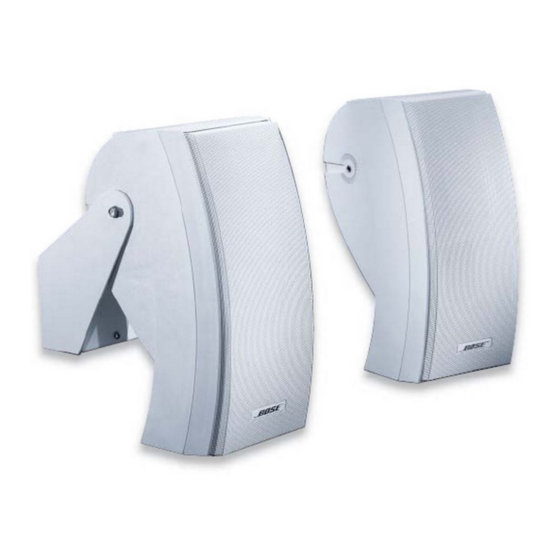Bose 302 A Manual de serviço - Página 6
Procurar online ou descarregar pdf Manual de serviço para Altifalantes Bose 302 A. Bose 302 A 10 páginas. Loudspeaker (commercial indoor/outdoor 70v/100v distributed applications)
Também para Bose 302 A: Manual do instalador (13 páginas), Ficha de dados técnicos (2 páginas), Manual do instalador (7 páginas)

Test setup note: Disconnect the input of the
speaker from the transformer for procedures
1-5.
1. Woofer Rub and Tick Test
1.1 Apply a 1 Vrms, 10Hz signal to the
speaker input terminal. No extraneous noises
such as rubbing, scraping or ticking should be
heard.
Note: To distinguish between normal suspen-
sion noise and rubs or ticks, slightly displace
the cone of the woofer with your fingers. If the
noise can be made to go away or get worse, it
is a rub or tick and the woofer should be
replaced. If the noise stays the same, it is
normal suspension noise and the woofer is
okay. Suspension noise will not be heard with
program material.
2. Air Leak Test
2.1 Apply an 8 Vrms, 65Hz signal to the
speaker input terminal.
2.2 Listen for air leaks around the cabinet
seams, the Twiddler™ driver panel, and the
woofer and Twiddler driver gaskets. Reposi-
tion or replace any gasket that is found to
leak. Repairs made to the cabinet seam
should not be visible from the exterior of the
speaker.
Note: A whooshing noise from the ports at
approximately 65Hz and 185Hz is acceptable
(port tuned frequencies).
3. Twiddler Driver Phase Test
3.1 Check the wiring of the Twiddler driver
against Figures 1 and 3.
4. Sweep Test
4.1 Apply an 8 Vrms, 10Hz signal to the
speaker input terminal.
4.2 Sweep the signal generator from 10Hz to
5 kHz and then back to 10Hz.
4.3 Apply a 3 Vrms, 5 kHz signal to the
speaker input terminal.
TEST PROCEDURES
4.4 Sweep the signal generator from 5 kHz to
15 kHz and then back to 5 kHz.
4.5 Listen for buzzes, rattles or other noises.
Redress any wire that buzzes; replace the
woofer or Twiddler driver if they are found to
be defective.
5. Woofer Phase Test
5.1 Observing polarity, momentarily apply 8
VDC to the speaker input terminal.
Note: To avoid damaging the speaker, only
momentarily apply the DC voltage.
5.2 The woofer should move outward with the
application of the DC voltage.
+
-
Green
6. Transformer Test
6.1 Connect the output of the transformer to
the speaker input terminal.
6.2 Apply a 35 Vrms, 50Hz signal to the input
of the transformer.
6.3 Sweep the signal generator from 50Hz to
5 KHz. Listen for clean undistorted audio
output.
6
22uF
Yellow
Yellow
Woofer
15uF
Green
1.5mH
11 Ohm
Figure 3. Schematic Diagram
Yellow
+
Twiddler driver 1
-
Gray
+
Twiddler driver 2
-
Red
